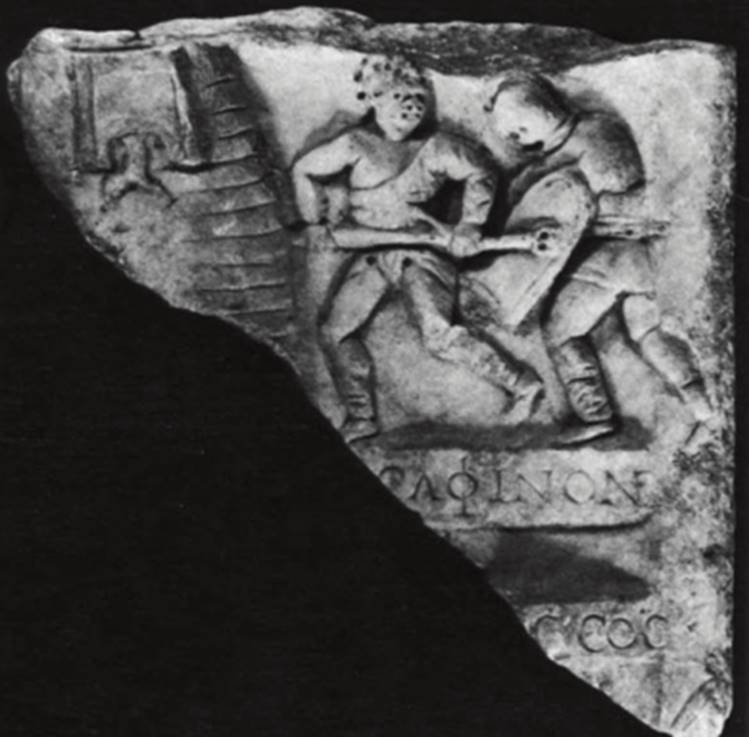Stele fragment with gladiators in combat. Eastern Mediterranean, 3rd-4th century Marble
The original right edge is preserved on this approximately triangular fragment; it was left in a rough chiseled state. The stele was probably an oblong, higher than wide, the most usual shape for these commemorative reliefs.
The extant surface is divided into three horizontal zones by narrow bands. The top shows two gladiators in animated combat; running to the left, a retiarius with a face protector thrusts his trident at the armored secutor pursuing him, who jabs with his sword from behind a round-topped shield. The retiarius wears a subligaculum and his left arm and shoulder are covered with bandaging for protection ; the secutor has his left leg covered for the same reason. His right leg overlaps the frame as does a shallowly incised tip of a palm frond near the lower right edge. The combatants run toward a beehive structure cut in very high relief; it may be a refuge for losing fighters (?) (von Bothmer, 1960-1961, p. 184), or, as part of the general apparatus of the amphitheater, a shelter for the “toreros" involved in sports events with animals (cf. Esperandieu, 1907, I, no. 609).

Each band separating the registers carries a partially preserved Greek inscription. These have been restored to read: (AG)AOINON ("Delphinos" in the accusative case) and (NAPKI)CCOC ("Narcissus") (Robert, 1971, p. 296). The zone between these bands is unworked.
The fragment of the bottom register can perhaps be restored as a victory image, a standing figure with palm branch—a formula for gladiators (e.g.,. Robert, 1971, no. 302) and charioteers alike (no. 94).
Commemorative, honorific, and funerary stelae with gladiators are well known in the Greek (Robert, 1971) and Latin (Faccenna, 1949-1950; Faccenna, 1956-1958) parts of the empire. Single combats were carved, or several aligned against a continuous background, or depicted in registers —illustrating either the victories of one gladiator or showing the different matches presented to the public by a donor; depending on its type, the stele would honor either the gladiator or the donor. The inscribed names of the athletes—both the defeated, frequently in the accusative, and the victor—might be next to the figures or on the top or bottom frame of the scene. The vigor of these figures and careful detailing most likely result from direct observation by the artist; the indifferent character of the modeling and the crude use of shallow drillwork to suggest shadows point to a date in the later third or early fourth century.
The relief was first noted in the Vigna Aquari, Rome (Matz and von Duhn, 1882, no. 3804). Bibliography: Lovatelli, 1895, p. 262, no. 14; von Bothmer, 1960-1961, pp. 183-184, fig. 5.
Date added: 2025-07-10; views: 159;
